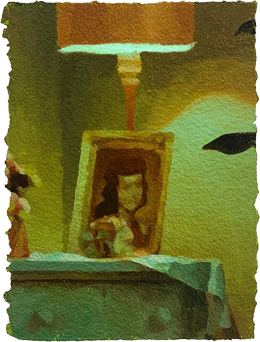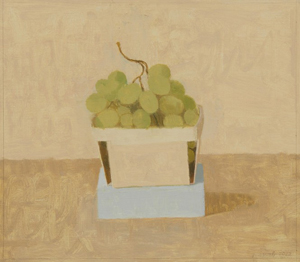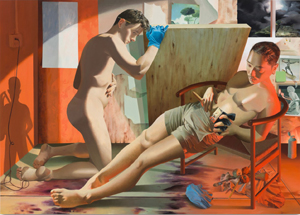Interiors or Still Life?
John Haberin New York City
Tim Wilson and Susan Jane Walp
Kyle Dunn and Martine Johanna
There are advantages in working from home. Tired of looking at a screen all day? You can look around you not to the sterility of a cubicle or an open office, but to a space that you call yours.
There are disadvantages, too, including that added temptation to look away. (I shall be lucky if I can complete this review.) But what do you see? Is it your surroundings, with their sense of home and its memories of those who call it home, or the objects within? Art history would call that a choice of genres, interior or still life—but are they all that different? Tim Wilson sees first a home haunted by memory and only now emerging from darkness, while Susan Jane Walp keeps returning to more than one idea of still life, but both tease out the very notion of the familiar. 
Clichés notwithstanding, the artists I know are as caring and sociable as the next person. They might have to be to break into the art world—or at least pretend to be so around the right people. Still, those who love them will always have a competitor for significant other, the artist's studio. In his paintings, Kyle Dunn shows off his surroundings, his skill, and his hoped for rewards. They show what might be the artist and an intimate, always looking but not often able to paint. They and Martine Johanna also show the difficulty and peril of reaching out.
Haunted houses
Many a house is haunted, not by ghosts, but by those who call it home. They leave their traces everywhere, not as wisps and shadows, but in what they leave behind. An empty room seems all the more haunting because nothing in it is alive—not the furnishings or the photograph on a table, the architecture or the paintings on the walls. The girl in a framed print might now be eternally young or eternally old. There is something of the past in her once fashionable dark curls and something of the present in a present generation's love. At least there would be if one could only pin either of them down.
Tim Wilson does not make it easy, but then he is more interested in layers of sense and sensation than in answers. He sees his subjects as caught up in an "infinite regress of thought and meaning," leaving it to him to "see them in context" and to "harness their meaning" in paint. If that sounds pretentious, he cannot help reflecting on what he sees and then reflecting on his reflections. What is their context? He is not letting on, but do not be surprised if it gets caught up in a regress, too. It is haunting all the same.
Wilson works on a modest scale that insists on how little he knows. It also places the work that much more between past and present. He works in oil on paper, mounted on panels. The ragged edges suggest fragments torn from something lost, but as objects in the gallery today. Close views fragment the interiors as well, leaving it to you to decipher the architecture and to know where you stand. He has plenty of lamps and mirrors, distorting or illuminating things, but I cannot swear that he ever shows the floor.
Dim light and lamp light keep things that much more at a distance. Unnatural colors recall the sepia prints of early photography, but in red, blue, or green. One work bathes a banister in red in front of yellow paneling and in proper perspective, but who knows where it leads? Scenes like these seem already history, with quaint furniture and quainter decor. Wilson closes in on a still life in an ornate frame, at once furniture within furniture and a painting within a painting. Just one work escapes the closed interior for a dark landscape that Jake Berthot or John Constable might have liked, but surely it, too, shows a painting.
What of that promised context and meaning? Wilson has seen the missing inhabitants, but not where you might think. He starts with screen captures from TV. That explains the quaintness, the tinting, and the blur. They set him apart from the heightened reality of new media and the immediacy of Pop Art, where everything on earth is a commercial for something else. Wilson has long since turned off the set.
Still life, as for Rachael Catharine Anderson today, has long been a matter of life and death. Dead animals and fruit past its prime served Dutch painting as allegories of vanity as much as displays of virtuosity. Andy Warhol has an obsession with reproducibility and death himself. Wilson's infinite regress precludes allegory, and he changes everything by painting it, dead or alive. If everything is awfully stagy, such is television. If everything is also opaque, such is art.
Two approaches to still life
Susan Jane Walp takes good care. It appears in the composition of her still life, each component set squarely into its shallow space. A basket of grapes rests with its rim parallel to the picture frame, the wall behind it, the back edge of a shelf or table, and a front edge that one will never see. Dark strips rise at either side of its pale brown cardboard, like supporting pillars. If objects themselves break the symmetry, one might expect no less from the stem of a poppy leaning for support to one side—or the black vase that contains it. The vase and its Etruscan design have been around longer than the artist, now in her seventies, and they are not going anywhere anytime soon, because they are first and foremost paint. 
Her care appears, too, in her brushwork, visible for all to see. There is nothing uniform about her surfaces or the light. The basket casts its shadow, with the same curved, extended shape in each of three versions, but to the right. Lighter strokes mix freely with medium and darker ones to the left and on the wall. Their care might be less evident were they more gestural, but Walp has little room for imperfections. Subjectivity is subordinate to the object at hand, whether the still life or the paint.
Everything unfolds before one's eyes, even as everything is designed to last. If that sounds like a contradiction, consider two approaches to still life. One makes a point of illusion, the illusion of the moment. Grapes by their nature will lose their freshness, and flowers are sure to wilt. They may be already dead, and Baroque painting took that as its moral, vanitas: you who value freshness and sensation will die, too.
The display of illusion became itself a tradition, of trompe l'oeil, or painting to fool the eye, but not everyone was buying in. Another tradition puts the stillness back in still life—the stillness of the thing itself. Jean-Siméon Chardin did so before the French revolution, and so did trompe l'oeil itself for William Harnett in nineteenth-century America. A violin or a book of Irish melodies no longer makes a sound, and a dead rabbit is really dead. Giorgio Morandi around 1950 cannot get enough stability and quiet. It is what makes him modern.
Visitors to Walp are likely to cite that later tradition, but I am not so sure. She shares Morandi's firm geometry and pale, mute colors, but with moist highlights for the light on water in a vase or the nasturtiums in the water. She prefers black cherries to red ones, to get the immediacy and darkness of both. She recycles the cardboard box that held the grapes at the market, even as she places it on a brick. A cork might attest to a newly opened bottle of wine, but free of stain, like the kind you keep around for when a new cork breaks. She pairs the roundness of an apple (yellow, of course) with a taller green vase as if weighing the difference.
At least one artist splits the difference, and it gave birth to modern art. Like Paul Cézanne, Walp treats everything as more lasting than the moment but tentative and unfinished. Her colors may or may not fully cover the rear wall. She works on paper, like Cézanne, but with much the same look as her oil on linen from ten years ago—or her brighter compositions from ten years before that. She can exude a studied elegance that I may distrust and that Modernism refused, but her doubts are showing, much like his. Her bricks have some of her deepest reds.
Significant others
Is Kyle Dunn painting lovers or alter egos? (The alternatives give new meaning to "significant other.") His characters spend much of the time naked, apart from socks, but unwilling or unable to look out or to look up. Each may have a canvas to himself, in a shallow space between piled temptations. It is a dizzying space, of books left out on the floor waiting for someone to topple them over, overflowing drawers, a standing mirror with further reflections,  and a window casting deep sunlight and shadow on the wall. Always there is room for oranges, a paper angel, and a colorful drink.
and a window casting deep sunlight and shadow on the wall. Always there is room for oranges, a paper angel, and a colorful drink.
In a striking exception, the men share that disorienting space, but only barely. One, who looks like he might be named Dunn, has a pencil behind his ear, while the other, who might be Latino, runs his fingers through a broad paintbrush. It could not conceivably have served Dunn's photorealism. The first kneels, and his shadow appears to carry a stick, perhaps an artist's maulstick (used to steady his hand), nowhere visible in the room. Each seems both calculating and impulsive, without letting on where their calculations or impulses are taking them. They may not know themselves.
Left to himself, the second figure looks, if anything, the more ruminative, with glasses above his thin mustache. The first, in turn, looks all the more helpless alone or with his dog, their bellies to the floor. A bird peeks in through the window, unless it is a double of the dog's tail. A unified space does emerge over the course of the show, perhaps a bedroom rather than a studio after all, but with its own compression and doubling. The window opens onto a balcony with a charming cast-iron railing, familiar enough from Henri Matisse. As Cecily Brown would remind you, a mirror in a self-portrait has been around still longer than modern art.
Often seen as rivals, Matisse and Picasso offer the dualism of an artist's significant other in their own way. One could make a handy biography of Pablo Picasso through portraits of his lovers. Matisse charted his career in painting his studios—from a dark cramped studio in Paris to the light, space, and paintings within a painting of The Red Studio. Dunn's subjects are sexually vulnerable but not having much sex. Their setting might win out after all, in its precision and temptations. It keeps coming closer to and further from the picture plane—and, in turn, to and from the artist and you.
Martine Johanna keeps trying out doubles, too, but do not go looking for others. In a show called "How to Eliminate Stress and Anxiety through Good Housekeeping," she has found relief in paring them away. That leaves her, mostly face on, but she, too, could use a place to stand and a connection to someone like you. Like Dunn, her image reappears slightly displaced within insets at a work's center, like mirrors or paintings, threatening to take over the show. An old, clunky TV set adds a further rectangle, but always turned off. She fondles it like an old friend, but it can no longer keep up.
It also carries her paintings that much further into three dimensions, especially in her one escape to the great outdoors. There her images multiply several times over in a not so idyllic landscape. She might be trying images on for size, not to mention feelings. Back indoors, shadows morph into harsh nut gripping colors, as vertical stripes crossing her face. She peers out from behind sunglasses, while an inset leaves the rest of a painting to the fullness of her hair. It recalls the popularity today of a woman's proud image, but pride, too, is just something to try on for size. Housekeeping is easy, but stress and anxiety linger on.

Tim Wilson ran at Nathalie Karg through April 15, 2023, Susan Jane Walp at Tibor de Nagy through April 15, Kyle Dunn at P.P.O.W. through May 13, and Martine Johanna at Massy Klein through May 20.




